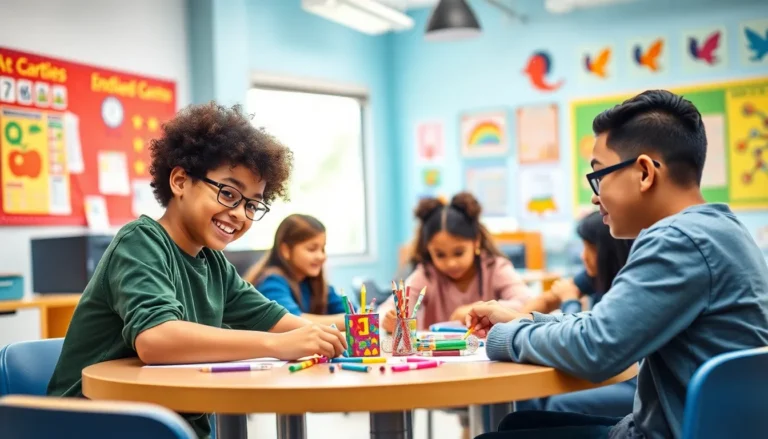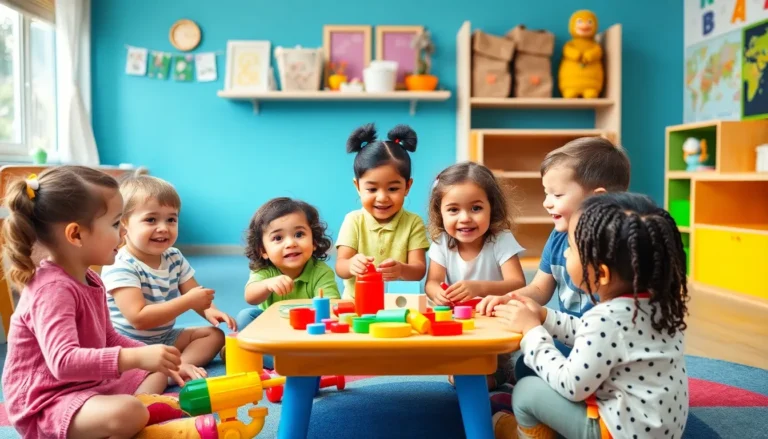Imagine a world where kids don’t just hear music but feel it in their bones. Music education for children isn’t just about learning notes and rhythms; it’s a magical journey that sparks creativity, boosts confidence, and even sharpens cognitive skills. Who knew that strumming a guitar or banging on a drum could be the secret sauce to a child’s development?
In a time when screens dominate playtime, introducing kids to the joy of music can be a game-changer. It’s like giving them a superpower—transforming their ability to express themselves and connect with others. So why not let your little ones dive into the enchanting world of melodies and harmonies? After all, every child deserves a chance to unleash their inner rock star or classical virtuoso.
Table of Contents
ToggleImportance Of Music Education For Children
Music education significantly influences children’s lives, offering advantages that extend beyond musical skills. Engaging with music nurtures creativity and cognitive development, shaping a child’s overall growth.
Cognitive Benefits
Music education enhances various cognitive skills. Children who study music tend to exhibit improved memory, attention, and problem-solving abilities. Studies show that musical training correlates with higher academic performance, particularly in mathematics and reading. Mastering an instrument stimulates brain development, leading to better auditory discrimination. Exposure to music also fosters critical thinking skills.
Emotional Development
Music education plays a vital role in emotional growth. Children gain confidence as they learn to perform in front of others. Participating in music activities fosters social connections, helping them build friendships. Music provides an emotional outlet, allowing children to express feelings they might struggle to verbalize. Empathy development increases as they engage with diverse musical genres and cultures. Enjoyment of music experiences promotes overall well-being, contributing to a balanced emotional toolkit.
Approaches To Music Education

Music education encompasses various methodologies aimed at developing children’s musical abilities. Each method serves to enhance creativity and cognitive skills in distinct ways.
Traditional Methods
Traditional methods focus on classical music education through structured lessons. This approach often centers on instrument mastery via formal training, emphasizing techniques and notation. Students typically learn music theory alongside performance skills. Instructors often use repetition, drills, and standard repertoire to build foundational skills. As children progress, they participate in recitals and ensembles, fostering teamwork and discipline. This method cultivates a deep appreciation for classical music while forming strong musical fundamentals.
Modern Techniques
Modern techniques incorporate technology and innovative teaching strategies. Programs might use music software and apps to engage children in interactive learning. Many educators emphasize improvisation and composition, allowing students to express their creativity freely. Collaborative projects and multi-genre explorations enhance engagement, promoting diversity in music appreciation. Culturally relevant material often finds its way into these lessons, connecting music to students’ lives. Teachers frequently employ varied learning styles to ensure all children access music education effectively.
Implementing Music Education
Effective implementation of music education calls for thoughtful strategies that maximize children’s engagement and learning outcomes.
Curriculum Design
Curriculum design plays a crucial role in music education. It should encompass a mix of traditional and contemporary teaching methods. Courses must include music theory, instrument practice, and composition. Integrating various musical genres promotes cultural awareness and relevance. For instance, using popular songs alongside classical pieces captures students’ interest. Flexibility in curriculum allows educators to adapt based on children’s needs and skills. Research demonstrates that a well-rounded curriculum enhances cognitive abilities and fosters emotional growth. The focus should center on fostering creativity while building foundational skills.
Classroom Activities
Classroom activities need to encourage active participation. Group performances create a sense of community among students. Additionally, improvisation exercises stimulate creativity and self-expression. Regular listening sessions not only expose children to diverse musical styles but also enhance auditory skills. Games that incorporate rhythm and melody make learning fun and interactive. Technology integration, such as music apps and software, offers engaging alternatives to traditional methods. Collaboration on small projects enables students to work together while developing social skills. Overall, a variety of activities maximizes children’s enjoyment and participation in music education.
Challenges In Music Education
Music education faces several challenges that can hinder its effectiveness.
Resource Limitations
Limited funding hampers many schools’ ability to provide quality music programs. Insufficient resources often lead to outdated instruments and lack of materials for both teachers and students. Schools with minimal budgets struggle to hire qualified music educators, which further impacts the quality of instruction. Access to music technology and equipment also remains scarce in resource-limited areas, resulting in lesser opportunities for hands-on learning. Ultimately, resource constraints can diminish children’s overall experience in music education.
Accessibility Issues
Accessibility issues create barriers for many children in accessing music education. Children with disabilities often encounter challenges in finding suitable programs that cater to their specific needs. Some schools do not provide adequate support, making it difficult for these students to participate fully. Additionally, geographic location can restrict access to high-quality music programs, especially in rural areas where offerings might be limited. By addressing these accessibility concerns, more children can engage in and benefit from music education.
Music education offers children a unique pathway to growth and development. It nurtures creativity and emotional expression while enhancing cognitive abilities that can translate into academic success. By embracing both traditional and modern teaching methods, parents and educators can create an engaging environment that fosters a lifelong love for music.
Despite the challenges faced in providing quality music education, efforts to improve accessibility and resources can ensure that every child has the opportunity to thrive musically. Encouraging children to explore music not only enriches their lives but also equips them with essential skills that extend beyond the classroom. Investing in music education is investing in a child’s future.





